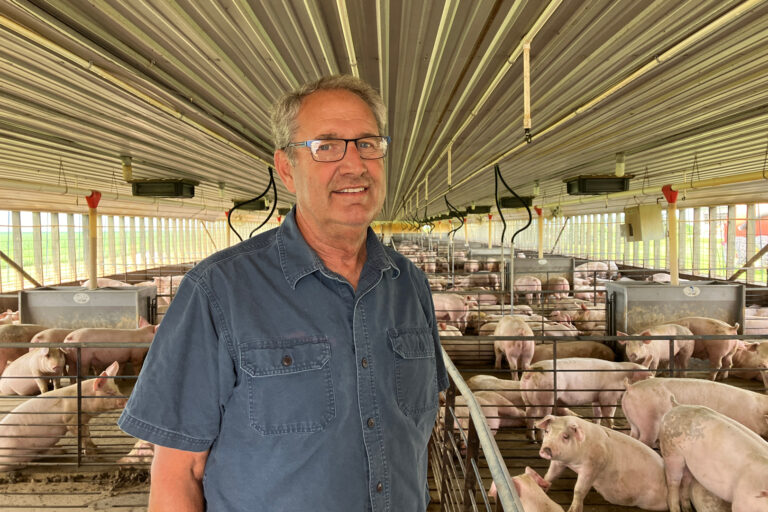On his farm near Gowrie, Iowa, Larry Alliger walked toward a row of low-roofed hog barns. He buys piglets from Colorado with his son, and between both of their operations, he said they can have around 20,000 pigs on hand.
They sell them to Tyson Foods through marketing contracts.
“We start loading these tomorrow, three o’clock. We have two loads in the morning that go to Storm Lake,” Alliger said.
Hauling hogs to the Tyson pork processing plant in Storm Lake, Iowa, over 70 miles away, is a big change for Alliger. For 35 years, he said he “almost always” went to the one in Perry, which was half the distance, until it shut down in June.
Alliger said he was disappointed when he heard the news but not necessarily surprised given the economic challenges across the industry. In 2023, producers in Iowa and the U.S. suffered record losses as costs outpaced profits.
“It’s been pretty brutal in the last year and a half. And even on Tyson’s side, they had a pretty tough year a year ago. And if they don’t make money, then they can’t afford to pay more either,” Alliger said.

Tyson itself reported a $648 million drop in income for fiscal year 2023. The company said it closed the single-shift plant in Perry to make overall operations more efficient.
While the Perry plant had capacity for 8,250 hogs per day, Tyson’s other Iowa facilities can process 17,250 in Storm Lake, 19,500 in Waterloo and 10,150 in Columbus Junction.
Alliger says he’s committed to sell to Tyson. But the Perry plant closure will mean more time on the road – an hour and 40 minutes to Storm Lake vs. 45 minutes to Perry – for each load of hogs. And extra minutes and miles cost more money.
It’s real dollars that they have to spend on transportation.
Tom Burkgren
Tom Burkgren is the former executive director of the American Association of Swine Veterinarians.
“It’s really more than just an inconvenience for pork producers to lose a plant like this,” Burkgren said.
He said nearly 100 pork producers, many of whom were his clients, had contracts with the Tyson plant in Perry. Most were shifted to the company’s other plants in Storm Lake and Waterloo.
“It’s real dollars that they have to spend on transportation and if they have an employee driving the truck, it’s longer hours on the road, and I really feel bad for producers,” Burkgren said.
Lee Schulz is an associate professor and Iowa State Extension livestock economist.
He said transportation costs are often part of the formula used in marketing contracts between producers and pork packers. However, they may not get updated right away.
“Those formulas are renegotiated on occasion. So it could be, you know, they could be annual, they could be three to five years.”
Until then, Schulz said producers may have to absorb the higher transportation costs.
Pork’s headwinds
Tyson isn’t the only company that’s closed pork facilities this year.
Smithfield Foods shuttered one of its processing plants in California last year and recently announced the same fate for its ham boning facility in Altoona, Iowa. HyLife also closed a plant in southwest Minnesota, and Olymel shuttered several in Canada.
Schulz said companies with multiple operations will shut down their least profitable, highest-cost sites when times get tough. Pork packers make these decisions knowing that they can absorb the supply of hogs at other plants.

To help explain why producers and packers have had several rough years, Schulz pointed to higher costs for labor, energy, and insurance, along with elevated interest rates and inflation. He said some producers may have spent more money to retrofit facilities or build new ones to comply with California’s proposition 12. The law requires more space for hogs in order for the pork to be sold in the state.
“But also you have the auditing and certification process and the tracing of the product, and all that adds additional cost to the system,” Schulz said.
These costs come on top of long-term shifts in the supply of hogs and capacity to process them.
After years of upward growth in the number of hogs, Schulz said pork packers increased their slaughter capacity nearly 10% between 2016 and 2020. They built new plants or upgraded existing ones to be more efficient.
“We’ve seen now, hog inventories roughly stabilize, pork demand has softened a bit since 2020, and 2021,” Schulz said.
And packers are adjusting to minimize losses.
The concern is that there’s less cushion to adjust to possible disruptions in the supply chain, and that cushion gets thinner each fall when there are more hogs ready for market.
This story was first produced by Iowa Public Media. This version is in partnership with Harvest Public Media, a collaboration of public media newsrooms in the Midwest. It reports on food systems, agriculture and rural issues.

